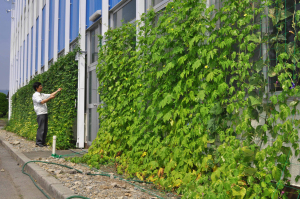Aug 26 2009
As part of its environmental protection activities, the Kyocera Group is growing morning glories and goya (bitter gourd) to form "Green Curtains," which are erected over trestles to shade portions of the outer walls and windows of manufacturing and office buildings at 12 locations throughout Japan. Through photosynthesis the plants absorb CO2, as well as create a screen over the windows preventing direct sunlight from raising the temperature of office interiors — thus reducing the need to use energy consuming air-conditioners.
 "Green Curtains" shading windows at Kyocera facility
"Green Curtains" shading windows at Kyocera facility
Kyocera first started growing Green Curtains at its Okaya Plant in Nagano Prefecture, Japan in 2007 as part of its energy conservation / global warming prevention activities, and since then they have also been adopted at other Kyocera Group locations throughout Japan. This year, four new locations have been added, making a total of 12 locations.
This year, Green Curtains grown at Kyocera Group locations stretch a total length of 294m (965ft), covering a total area of 775m2 (8,342ft2). The growth of these Green Curtains will be able to absorb roughly 2,713kg-CO2 (5981lb-CO2) per year,* or roughly the same amount as 194 cedar trees.**
* CO2 absorption (3.5kg) X Area of Green Curtain (m2) = Volume of yearly CO2 absorption. (Source: Rural Culture Association Japan)
** One cedar tree absorbs 14kg/year of CO2. (Source: Forestry Agency of Japan)
Thanks to the Green Curtain’s ability to block out the strong summer sunlight from shining directly through the windows, Kyocera Okaya and Gamo plants no longer need to use air-conditioning in the offices during the morning hours — thus allowing them to conserve energy.
Furthermore, the soft green color of the foliage which shades the windows creates a relaxing atmosphere, which has become a topic of conversation for both employees and visitors at the various locations.
After experiencing the benefits of the Green Curtains at work, many employees have also taken up the activity at their own homes.